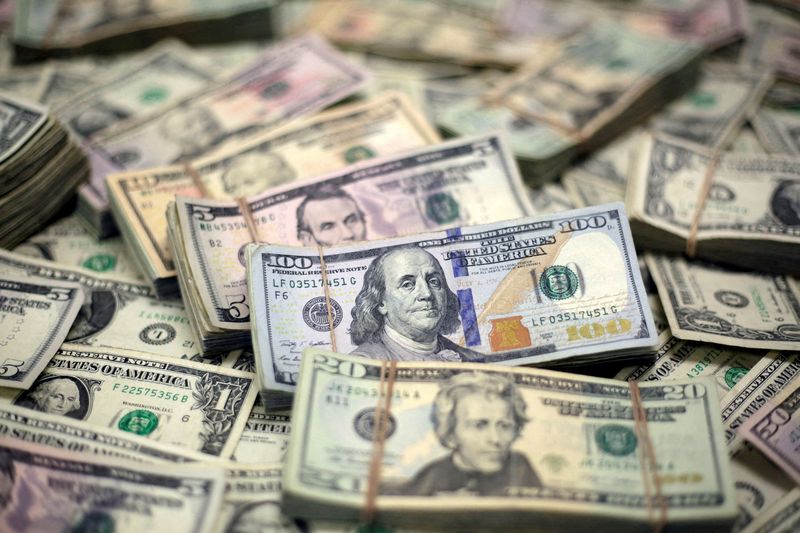
By Saqib Iqbal Ahmed
NEW YORK (Reuters) -Traders gauging how to play further downside in the U.S. dollar are looking to the relative strength of economies around the world, as interest rate shifts from global central banks shake up currency markets.
The U.S. dollar index fell 4.8% against a basket of currencies in the third quarter, its worst quarterly performance in nearly two years. Pressure on the U.S. currency increased after the Fed delivered a jumbo-sized 50 basis point cut last month, its first reduction since 2020.
How much further the dollar falls and which currencies will benefit may largely be a question of yields. For years, U.S. yields have stood above most developed economies, bolstering the dollar’s allure against its peers.
That picture is shifting, with the Fed and most other central banks cutting interest rates to safeguard economic growth. Many traders betting against the buck are doing so through currencies whose yield gap with the dollar is expected to narrow.
Net bets on a weaker dollar have grown to $14.1 billion in futures markets, the highest level in about a year, Commodity Futures Trading Commission data showed. The path lower for the dollar, however, is likely to be a bumpy one.
The comparatively strong U.S. economy could limit how much the Fed cuts rates, complicating the outlook for further dollar declines. Meanwhile, the U.S. presidential election and geopolitical worries threaten to inject further volatility into currency markets in coming weeks.
“It’s not just necessarily ‘sell the dollar and buy everything,'” said Jack McIntyre, portfolio manager at Brandywine Global. “You have to be a little more selective.”
While the dollar index is little changed for the year, it is down about 5% from its April high, with the currency notching drops against several developed market peers as U.S. yields fell in anticipation of monetary policy easing by the Fed.
Some of the risks to the weaker dollar view became more apparent in recent days.
The dollar rose sharply against the British pound on Thursday after the Bank of England said it could move more aggressively to cut interest rates if inflation pressures continued to weaken.
A day before, data showed euro zone inflation dipped below 2% for the first time since mid-2021 in September, reinforcing the case for the European Central Bank to cut rates this month, a potential source of weakness for the euro.
The dollar’s role as a safe haven has also been on display as Middle East tensions have escalated in recent days.
From the U.S. side, Friday’s labor market data could help shape views on how much the Fed might cut rates for the rest of the year.
Though futures markets show an additional 68 basis points of cuts priced in, a strong number could bolster the case for more moderate policy easing. However, “if we are entering a soft patch for the U.S. economy, the market is going to discount more cuts into the curve and that will weaken the dollar,” said Christian Dery, head of macro strategy at Capital Fund Management.
Nevertheless, investors believe more downside remains for the dollar in some corners of the market.
Paresh Upadhyaya, director of fixed-income and currency strategy at Amundi US, said he is looking for “idiosyncratic stories like widening interest rate differentials caused by a divergence in monetary policy.”
His plays on a weaker dollar include positions in the Norwegian krone and Australian dollar. Norway’s central bank recently held its policy interest rate at a 16-year high, signaling any cuts must wait until early 2025. Australia’s central bank held rates steady last week and said interest rate cuts were unlikely in the near term.
Upadhyaya also added to a position in the Brazilian real. Unlike many of its peers, Brazil’s central bank hiked rates last month as it looks to tackle a challenging inflation outlook. The Brazilian real is down about 10% against the dollar this year.
The Japanese yen could also find further support from diverging central bank policy, investors said. The Bank of Japan tightened rates to 0.25% in July in a landmark shift away from a decade-long stimulus program aimed at firing up economic growth.
Though the Bank of Japan has signaled it is in no rush to raise rates further, the narrowing gap between rates in Japan and the U.S. has already fueled a 10% rally in the yen from its 2024 lows against the dollar. Net bullish bets on the currency against the dollar stand at $5.8 billion, CFTC data showed.
“With global central banks also starting to cut rates, the biggest gainer versus the USD will be in the likes of the (yen),” said Natsumi Matsuba, head of FX trading and portfolio management at Russell Investments.
An analysis of currency valuations based on metrics such as purchasing power parity and real effective exchange rates released by BofA Global Research last month showed that the yen and Norwegian krone are among the developed world’s most undervalued currencies. The dollar and Swiss franc are the two most overvalued, the study found.
Whatever their positioning, however, investors must also contend with potential volatility surrounding the U.S. presidential election, slated for Nov. 5.

Uncertainty in the weeks before the vote could send safety-seeking investors to the dollar. Many investors also believe a win by Republican candidate Donald Trump could buoy the dollar.
“The wild card in any forecast right now for our currency is the U.S. election,” said Brandywine’s McIntyre, who remains bearish on the U.S. dollar, but less so than before the currency’s recent slide. “That’s why it’s hard to be super convicted.”
This post is originally published on INVESTING.




